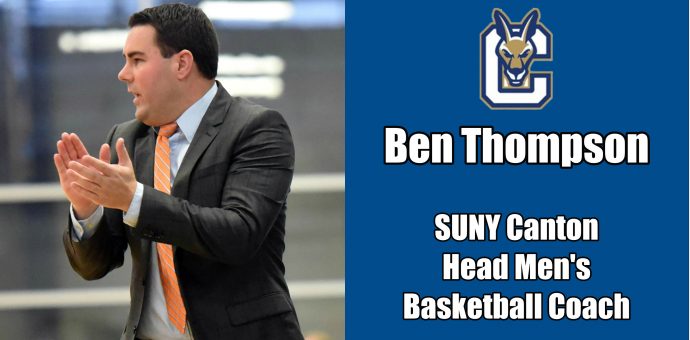This article was written by SUNY Canton Head Men’s Basketball Coach Ben Thompson
We all understand the coaching dynamics and rapport that is needed between coaches and players to form a good culture. However, we still are sometimes frustrated and unsure why our program’s culture and the chemistry amongst our student-athletes aren’t as we expect them to be. Sometimes, but not in all cases, we tend to lose sight of the bottom up approach to develop this within our programs.
We all want to have successful winning seasons every year with championship results. However, every season is going to be different, even if you are returning every single player. Student-athletes grow, learn, develop, and mature at different rates. They develop new friendships and relationships, while losing old ones.
Who they are changes during college, as well as who or what their influences are. We have all chosen a profession that deals with young people during one of the most crucial stages of life and one that has the most changes within an individual. Sometimes we don’t realize the impact that we have on those under our tutelage. Hopefully this article will be a good reminder of the importance of developing and maintaining relationships with all of the players in your program.
Authentic Relationships with Players
The relationships between coaches and players are paramount to the success of any program. Most of the time, relationships develop more easily between the coaching staff and the better players on the team. The reason for this, is as you know, we need these players to help us become successful. However, we fail to realize, that true chemistry and culture comes from the bottom of our benches.
I understand that the better players and the captains can set the tone of a culture. But many times, the best players and the ones that contribute in games are willing to do whatever is asked of them because they are happy and satisfied. They put in the work and they see the results, they get the credit or blame, and they are satisfied because they are being rewarded for their work. Sometimes though it is more difficult for those at the end of the bench to reach the same level of joy and satisfaction.
As coaches, we can sit on our high horse at times and think, “well they should just be happy to be on the team.” I understand that they might not be as talented and may not have the direct impact upon winning as our better players, but they have the biggest impact upon chemistry and culture within the team.
The “bottom” guys are the ones that sacrifice the most. In many cases, they work just as hard as the guys who play, and they do so knowing that they won’t step foot on the court. However, they have similar passions, prides, and a need for acceptance as the guys who do get to play. Unhappy team members can bring everyone down and can kill the energy and excitement within a program.
Our relationships with the “bottom” guys are so incredibly important to our program’s success, culture, and chemistry. In many cases, we may need to spend more time with them to let them know how appreciated they are and how important they are to everyone’s success. Point out the things that they do well as often as you can, build them up in front of the team and privately. Their influence on your team and in the locker room can be huge.
Most teams have an average of 15 players, but we can only give 7-8, sometimes 10, enough minutes to keep them happy over the course of the season. In many cases, that leaves half of the team unhappy with their playing time and role. However, they can be happy in knowing their importance and in knowing how much they are appreciated, and how much their work and their contributions are valued. This only happens though if we take the time as coaches to express this gratitude. We must be willing to make a conscious effort to make sure that all of our players are feeling valued, regardless of the role that they play.
The Tangible Value Provided by Bench Players
Outside of the fact that relationships help your team’s overall culture, the bottom half of your roster brings real value to your team. What they do on a daily basis is going to directly impact your team’s wins and losses.
How many times have you seen a key player go down to injury, or is not able to play because of grades or team discipline? If you are investing into the bottom half of your bench and have the mentality of “next man up,” you may be surprised with the production that you get from one of your “end of the bench” players that steps up and fills a key role.
Also, if you have younger players that aren’t getting very many minutes but have a potential to help you down the line, you need to keep them engaged and getting better. In a culture of transfer if it doesn’t workout right away, you especially need to have an authentic relationship with your younger players. One where they believe and trust what you are telling them about putting in the time.
If not, you are going to lose out on some great players because they are not feeling valued. It is all about perception. You can value a certain player in your mind, but if they are not experiencing what they perceive as being valued, they are not going to be happy.
We all know that a team is only as good as they practice, and this means that you need the second half of your team bringing it everyday. If you are not regularly communicating with the bottom half of your team they are going to checkout midway through the year, without a doubt. This means that practice intensity levels are not nearly where they need to be at, and this will most definitely lead into poor game play for the starters and rotation players who are not being tested and challenged in practice.
When you have bench players that are willing to bring it everyday and are looking to go to war with the starters, it makes all the difference in the world. This only happens though if you are making sure that this role is valued and appreciated. You do this by developing an authentic relationship with all of your players, regardless of playing time.
Conclusion
In general, student-athletes aren’t the means to an end, they are the ends in themselves. Building relationships with those players who work just as hard, but may not be as rewarded on the court, can sometimes have more of an impact on team chemistry and culture than with your best players. Showing these team members love and giving them extra attention can in many cases be the difference in positive team chemistry and culture.








